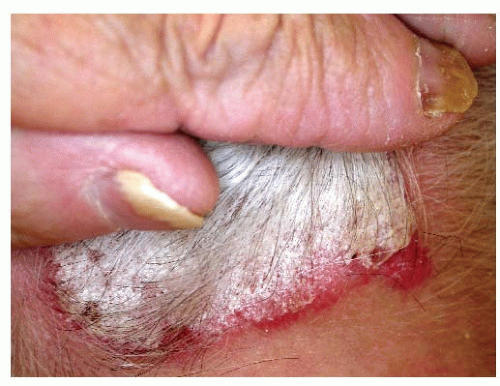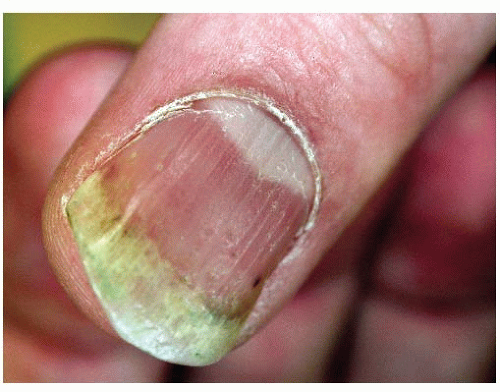Management of Psoriasis
Peter C. Schalock
Arthur J. Sober
Psoriasis is a common chronic skin disease characterized by discrete and confluent erythematous papules and plaques covered with silvery white scale; its prevalence approaches 3% of the adult populations in the United States and northern Europe. Varieties include pustular and erythrodermic forms; a destructive arthritis may also develop. Patients present with cosmetic concerns and requests for relief from itching and pain. Treatment strategy depends on the type of psoriasis present, location, severity, age, and medical history. The primary physician should be able to treat mild and localized forms of the disease and be knowledgeable about approaches to more severe disease, ensuring appropriate referral and collaboration with the dermatologist and/or rheumatologist.
Pathophysiology
The epidermal turnover time for a cell to travel from the basal cell layer of the epidermis to the granular layer is normally 14 days. In psoriatic skin, it is reduced to 2 to 3 days. Normal cell maturation cannot take place in this short time, leading to faulty keratinization. Clinically, this process leads to scaling. Histologically, the epidermis is thickened, and immature nucleated cells are seen in the stratum corneum. An accompanying dilation of the subepidermal blood vessels and infiltration with mononuclear cells account for the characteristic erythema. Neutrophils are often seen within the stratum corneum, forming characteristic micropustules.
The exact causes of this abnormal cellular proliferation and inflammation are unknown, but it is conjectured that genetically predisposed persons experience T-cell activation in response to antigen stimulation. Inheritance is multifactorial, with genetic determinants overlapping with those of atopic dermatitis, rheumatoid arthritis, and Crohn disease. Multiple gene loci have been identified, the most common being PSORS1 at chromosome 6p21. Affected individuals have an increased incidence of several HLA antigens, including HLA-B27 in patients with psoriatic arthritis. HLA-Cw6 is strongly associated with familial, early-onset psoriasis. Psoriatic plaques are rich in activated T lymphocytes, which are capable of inducing both cellular proliferation and inflammation. Interleukin-22 (IL-22) may play a role in the thickening of the skin seen in psoriasis. IL-12 and IL-23 cytokines are overexpressed in psoriatic plaques;
administration of monoclonal antibodies directed against them produces significant clinical improvement, strongly implicating these cytokines in pathogenesis. The search for responsible antigens is ongoing.
administration of monoclonal antibodies directed against them produces significant clinical improvement, strongly implicating these cytokines in pathogenesis. The search for responsible antigens is ongoing.
Drug-exacerbated psoriasis offers some insights into disease mechanisms: Lithium is believed to enhance the release of inflammatory mediators from neutrophils; beta-blockers decrease cyclic AMP-dependent protein kinase (an inhibitor of cell proliferation); and nonsteroidal anti-inflammatory drugs can cause a buildup of the inflammatory mediator arachidonic acid. Other medications associated with exacerbations include antimalarials and interferon; a flare may follow withdrawal of systemic corticosteroids. Drug-induced exacerbations can be severe and unpredictable.
Clinical Presentation
Psoriasis usually develops in early adult life, but the disease may appear in childhood or old age; 70% of patients report onset between the ages of 16 and 22 years, usually with a positive family history and a tendency toward more severe disease. A second, less common peak is between 55 and 60 years, characterized by milder disease and little family history.
Plaque psoriasis is the most common form, presenting with well-marginated, erythematous, elevated papules or plaques, which, if not previously treated by the patient, also show thick, silvery scaling (Figs. 187-1 and 187-2). Removal of this scale reveals punctate bleeding points known as Auspitz sign. Nails often show punctuate irregular pitting and a characteristic discoloration of the surface of the nail that resembles a drop of oil (Fig. 187-3). Subungual collections of keratotic material are also common, with distal separation of the nail from the nail bed. Mucous membranes are rarely involved. Commonly affected sites are extensor surfaces of the arms and legs as well as the scalp. Skin trauma increases the risk of involvement (koebnerization), and any epidermal surface may become involved, even the mucosa. Other triggering factors include infections (most commonly streptococcal pharyngitis), HIV infection; hypocalcemia; psychogenic stress; drugs (see later discussion); obesity; increased alcohol consumption; and/or tobacco smoking.
Guttate psoriasis, which presents with small, discrete, erythematous papular lesions, is often preceded by a streptococcal infection. An exfoliative or erythrodermic form of psoriasis shows generalized erythema without any characteristic lesions of psoriasis. Localized pustular psoriasis with sterile pustules of the palms and soles may also be seen without other characteristic lesions. An uncommon but serious variant is generalized pustular psoriasis, which is often accompanied by systemic symptoms and risk of circulatory collapse. Patients with the acquired immunodeficiency syndrome may also develop extensive psoriasis that is recalcitrant to therapy.
Psoriatic arthritis can be a destructive process that is often polyarticular and asymmetric, although single joint involvement does occur. Most commonly involved are the proximal interphalangeal and distal interphalangeal joints of the hands and feet (metacarpophalangeal joints are rarely involved, in comparison to the situation with regard to rheumatoid arthritis). Classic manifestations include sausage-shaped swelling and deformity of the distal interphalangeal joints in association with the characteristic nail changes. Juxtaarticular inflammation produces the sausage-like swelling. Radiologic features include interphalangeal joint erosion (pencil-in-a-cup appearance) and erosion of the distal tuft. The skin disease usually precedes the
joint disease by months to years, but arthritis may occur prior to skin findings in 10% to 15% of patients.
joint disease by months to years, but arthritis may occur prior to skin findings in 10% to 15% of patients.
The clinical course of psoriasis is characterized by chronicity and seasonal fluctuations, with improvement in the summer due to sun exposure and worsening in the winter.








